P4. Concepts and philosophies of organisational behaviour
VerifiedAdded on 2021/01/02
|17
|4731
|109
AI Summary
Contribute Materials
Your contribution can guide someone’s learning journey. Share your
documents today.
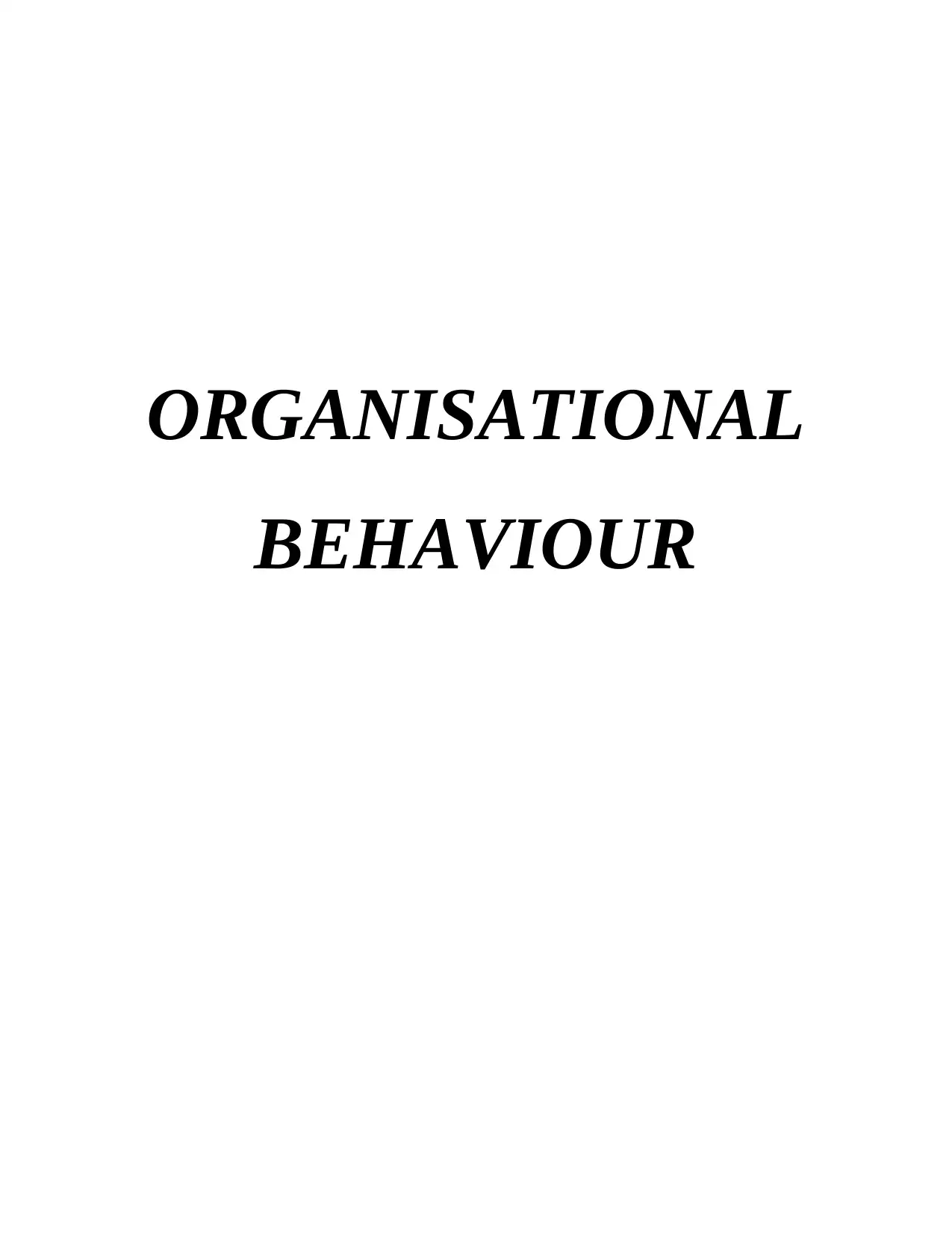
ORGANISATIONAL
BEHAVIOUR
BEHAVIOUR
Secure Best Marks with AI Grader
Need help grading? Try our AI Grader for instant feedback on your assignments.
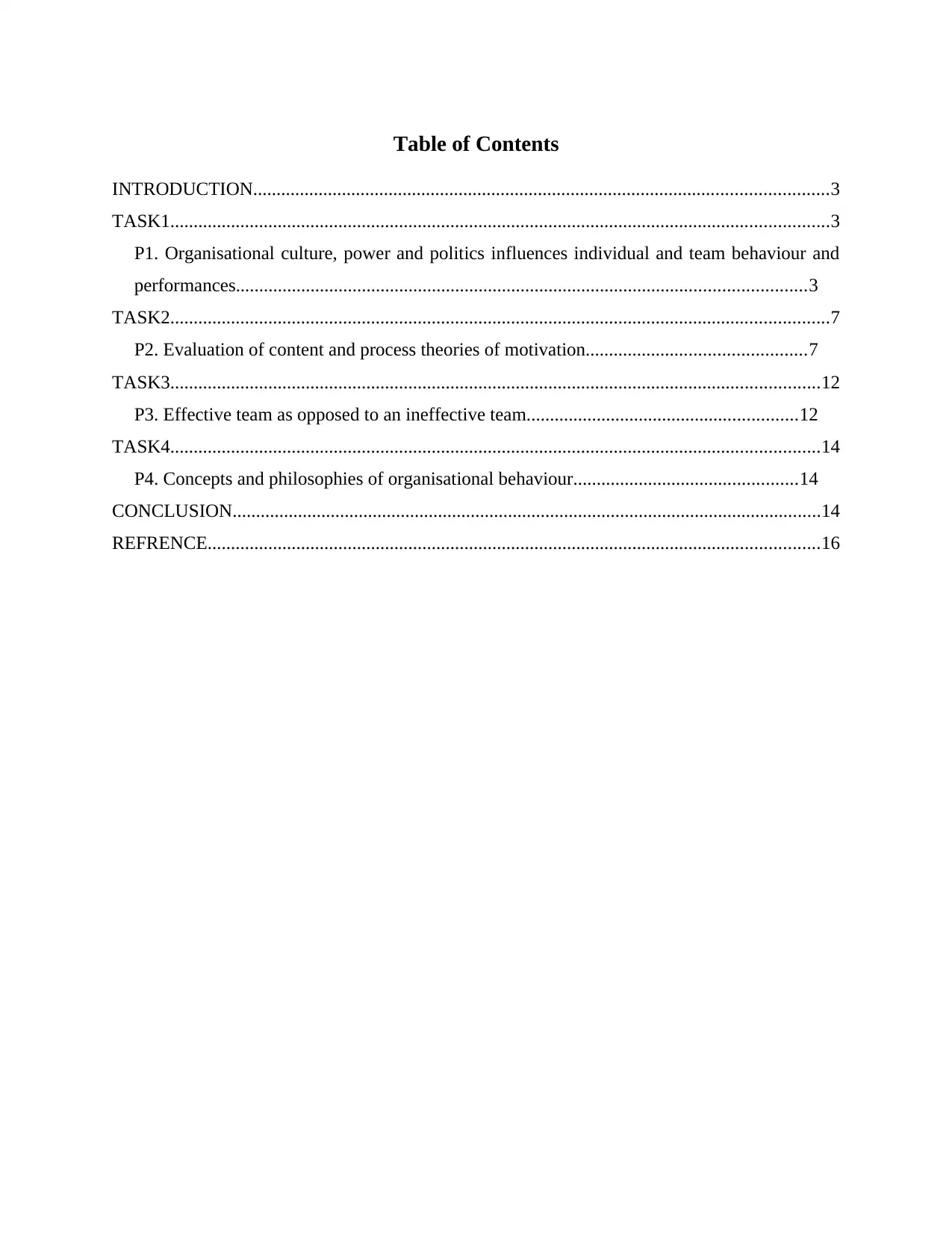
Table of Contents
INTRODUCTION...........................................................................................................................3
TASK1.............................................................................................................................................3
P1. Organisational culture, power and politics influences individual and team behaviour and
performances..........................................................................................................................3
TASK2.............................................................................................................................................7
P2. Evaluation of content and process theories of motivation...............................................7
TASK3...........................................................................................................................................12
P3. Effective team as opposed to an ineffective team..........................................................12
TASK4...........................................................................................................................................14
P4. Concepts and philosophies of organisational behaviour................................................14
CONCLUSION..............................................................................................................................14
REFRENCE...................................................................................................................................16
INTRODUCTION...........................................................................................................................3
TASK1.............................................................................................................................................3
P1. Organisational culture, power and politics influences individual and team behaviour and
performances..........................................................................................................................3
TASK2.............................................................................................................................................7
P2. Evaluation of content and process theories of motivation...............................................7
TASK3...........................................................................................................................................12
P3. Effective team as opposed to an ineffective team..........................................................12
TASK4...........................................................................................................................................14
P4. Concepts and philosophies of organisational behaviour................................................14
CONCLUSION..............................................................................................................................14
REFRENCE...................................................................................................................................16
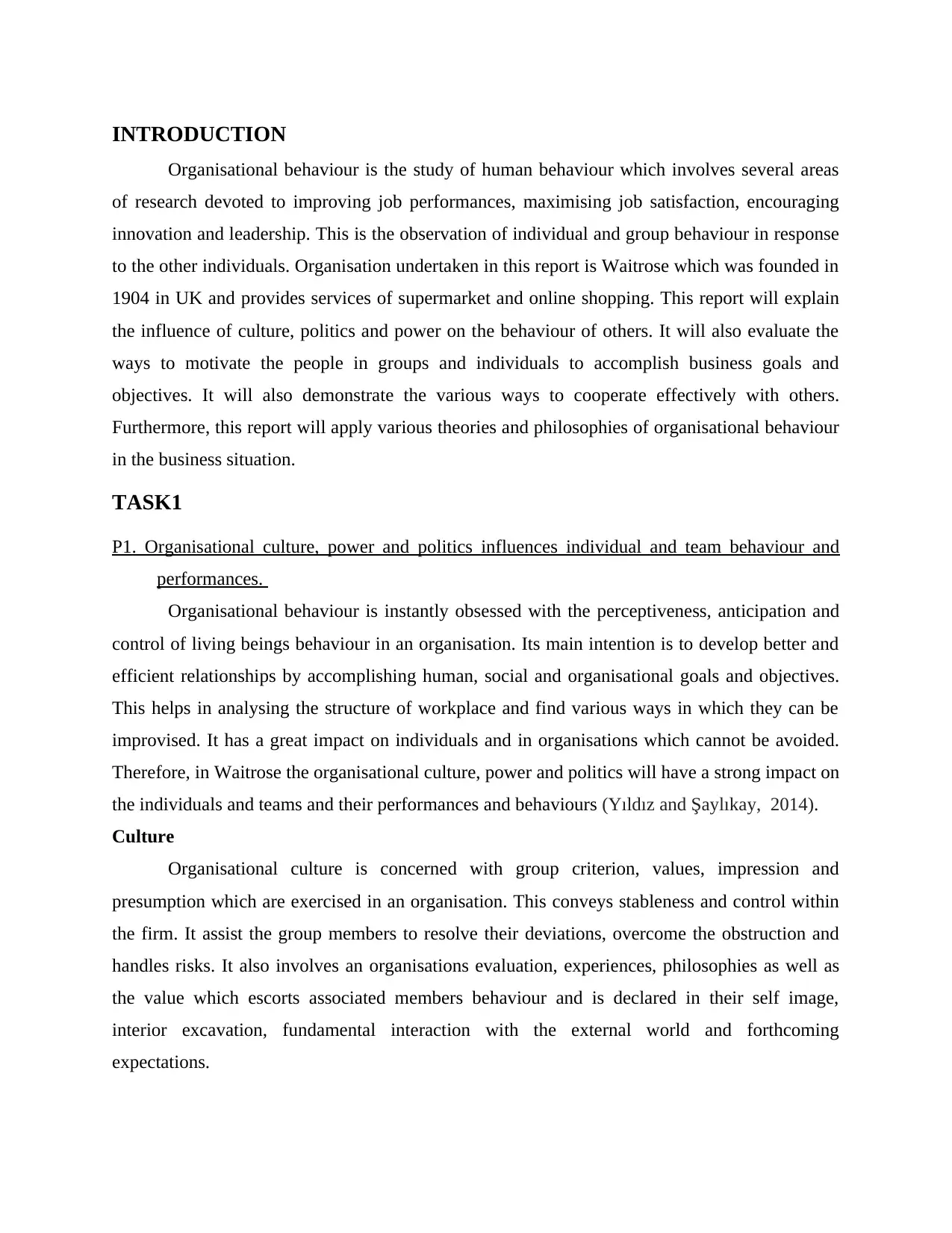
INTRODUCTION
Organisational behaviour is the study of human behaviour which involves several areas
of research devoted to improving job performances, maximising job satisfaction, encouraging
innovation and leadership. This is the observation of individual and group behaviour in response
to the other individuals. Organisation undertaken in this report is Waitrose which was founded in
1904 in UK and provides services of supermarket and online shopping. This report will explain
the influence of culture, politics and power on the behaviour of others. It will also evaluate the
ways to motivate the people in groups and individuals to accomplish business goals and
objectives. It will also demonstrate the various ways to cooperate effectively with others.
Furthermore, this report will apply various theories and philosophies of organisational behaviour
in the business situation.
TASK1
P1. Organisational culture, power and politics influences individual and team behaviour and
performances.
Organisational behaviour is instantly obsessed with the perceptiveness, anticipation and
control of living beings behaviour in an organisation. Its main intention is to develop better and
efficient relationships by accomplishing human, social and organisational goals and objectives.
This helps in analysing the structure of workplace and find various ways in which they can be
improvised. It has a great impact on individuals and in organisations which cannot be avoided.
Therefore, in Waitrose the organisational culture, power and politics will have a strong impact on
the individuals and teams and their performances and behaviours (Yıldız and Şaylıkay, 2014).
Culture
Organisational culture is concerned with group criterion, values, impression and
presumption which are exercised in an organisation. This conveys stableness and control within
the firm. It assist the group members to resolve their deviations, overcome the obstruction and
handles risks. It also involves an organisations evaluation, experiences, philosophies as well as
the value which escorts associated members behaviour and is declared in their self image,
interior excavation, fundamental interaction with the external world and forthcoming
expectations.
Organisational behaviour is the study of human behaviour which involves several areas
of research devoted to improving job performances, maximising job satisfaction, encouraging
innovation and leadership. This is the observation of individual and group behaviour in response
to the other individuals. Organisation undertaken in this report is Waitrose which was founded in
1904 in UK and provides services of supermarket and online shopping. This report will explain
the influence of culture, politics and power on the behaviour of others. It will also evaluate the
ways to motivate the people in groups and individuals to accomplish business goals and
objectives. It will also demonstrate the various ways to cooperate effectively with others.
Furthermore, this report will apply various theories and philosophies of organisational behaviour
in the business situation.
TASK1
P1. Organisational culture, power and politics influences individual and team behaviour and
performances.
Organisational behaviour is instantly obsessed with the perceptiveness, anticipation and
control of living beings behaviour in an organisation. Its main intention is to develop better and
efficient relationships by accomplishing human, social and organisational goals and objectives.
This helps in analysing the structure of workplace and find various ways in which they can be
improvised. It has a great impact on individuals and in organisations which cannot be avoided.
Therefore, in Waitrose the organisational culture, power and politics will have a strong impact on
the individuals and teams and their performances and behaviours (Yıldız and Şaylıkay, 2014).
Culture
Organisational culture is concerned with group criterion, values, impression and
presumption which are exercised in an organisation. This conveys stableness and control within
the firm. It assist the group members to resolve their deviations, overcome the obstruction and
handles risks. It also involves an organisations evaluation, experiences, philosophies as well as
the value which escorts associated members behaviour and is declared in their self image,
interior excavation, fundamental interaction with the external world and forthcoming
expectations.
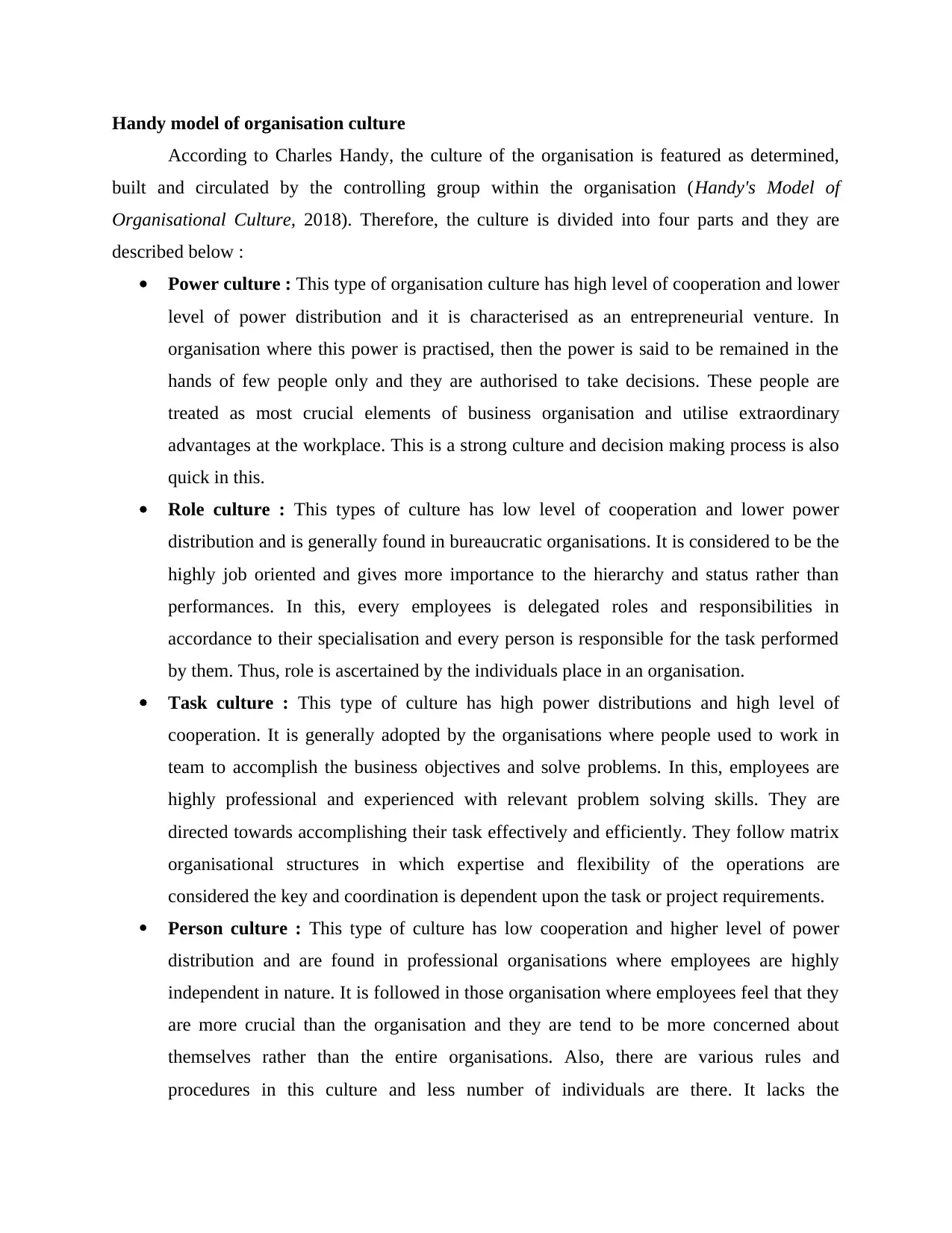
Handy model of organisation culture
According to Charles Handy, the culture of the organisation is featured as determined,
built and circulated by the controlling group within the organisation (Handy's Model of
Organisational Culture, 2018). Therefore, the culture is divided into four parts and they are
described below :
Power culture : This type of organisation culture has high level of cooperation and lower
level of power distribution and it is characterised as an entrepreneurial venture. In
organisation where this power is practised, then the power is said to be remained in the
hands of few people only and they are authorised to take decisions. These people are
treated as most crucial elements of business organisation and utilise extraordinary
advantages at the workplace. This is a strong culture and decision making process is also
quick in this.
Role culture : This types of culture has low level of cooperation and lower power
distribution and is generally found in bureaucratic organisations. It is considered to be the
highly job oriented and gives more importance to the hierarchy and status rather than
performances. In this, every employees is delegated roles and responsibilities in
accordance to their specialisation and every person is responsible for the task performed
by them. Thus, role is ascertained by the individuals place in an organisation.
Task culture : This type of culture has high power distributions and high level of
cooperation. It is generally adopted by the organisations where people used to work in
team to accomplish the business objectives and solve problems. In this, employees are
highly professional and experienced with relevant problem solving skills. They are
directed towards accomplishing their task effectively and efficiently. They follow matrix
organisational structures in which expertise and flexibility of the operations are
considered the key and coordination is dependent upon the task or project requirements.
Person culture : This type of culture has low cooperation and higher level of power
distribution and are found in professional organisations where employees are highly
independent in nature. It is followed in those organisation where employees feel that they
are more crucial than the organisation and they are tend to be more concerned about
themselves rather than the entire organisations. Also, there are various rules and
procedures in this culture and less number of individuals are there. It lacks the
According to Charles Handy, the culture of the organisation is featured as determined,
built and circulated by the controlling group within the organisation (Handy's Model of
Organisational Culture, 2018). Therefore, the culture is divided into four parts and they are
described below :
Power culture : This type of organisation culture has high level of cooperation and lower
level of power distribution and it is characterised as an entrepreneurial venture. In
organisation where this power is practised, then the power is said to be remained in the
hands of few people only and they are authorised to take decisions. These people are
treated as most crucial elements of business organisation and utilise extraordinary
advantages at the workplace. This is a strong culture and decision making process is also
quick in this.
Role culture : This types of culture has low level of cooperation and lower power
distribution and is generally found in bureaucratic organisations. It is considered to be the
highly job oriented and gives more importance to the hierarchy and status rather than
performances. In this, every employees is delegated roles and responsibilities in
accordance to their specialisation and every person is responsible for the task performed
by them. Thus, role is ascertained by the individuals place in an organisation.
Task culture : This type of culture has high power distributions and high level of
cooperation. It is generally adopted by the organisations where people used to work in
team to accomplish the business objectives and solve problems. In this, employees are
highly professional and experienced with relevant problem solving skills. They are
directed towards accomplishing their task effectively and efficiently. They follow matrix
organisational structures in which expertise and flexibility of the operations are
considered the key and coordination is dependent upon the task or project requirements.
Person culture : This type of culture has low cooperation and higher level of power
distribution and are found in professional organisations where employees are highly
independent in nature. It is followed in those organisation where employees feel that they
are more crucial than the organisation and they are tend to be more concerned about
themselves rather than the entire organisations. Also, there are various rules and
procedures in this culture and less number of individuals are there. It lacks the
Secure Best Marks with AI Grader
Need help grading? Try our AI Grader for instant feedback on your assignments.
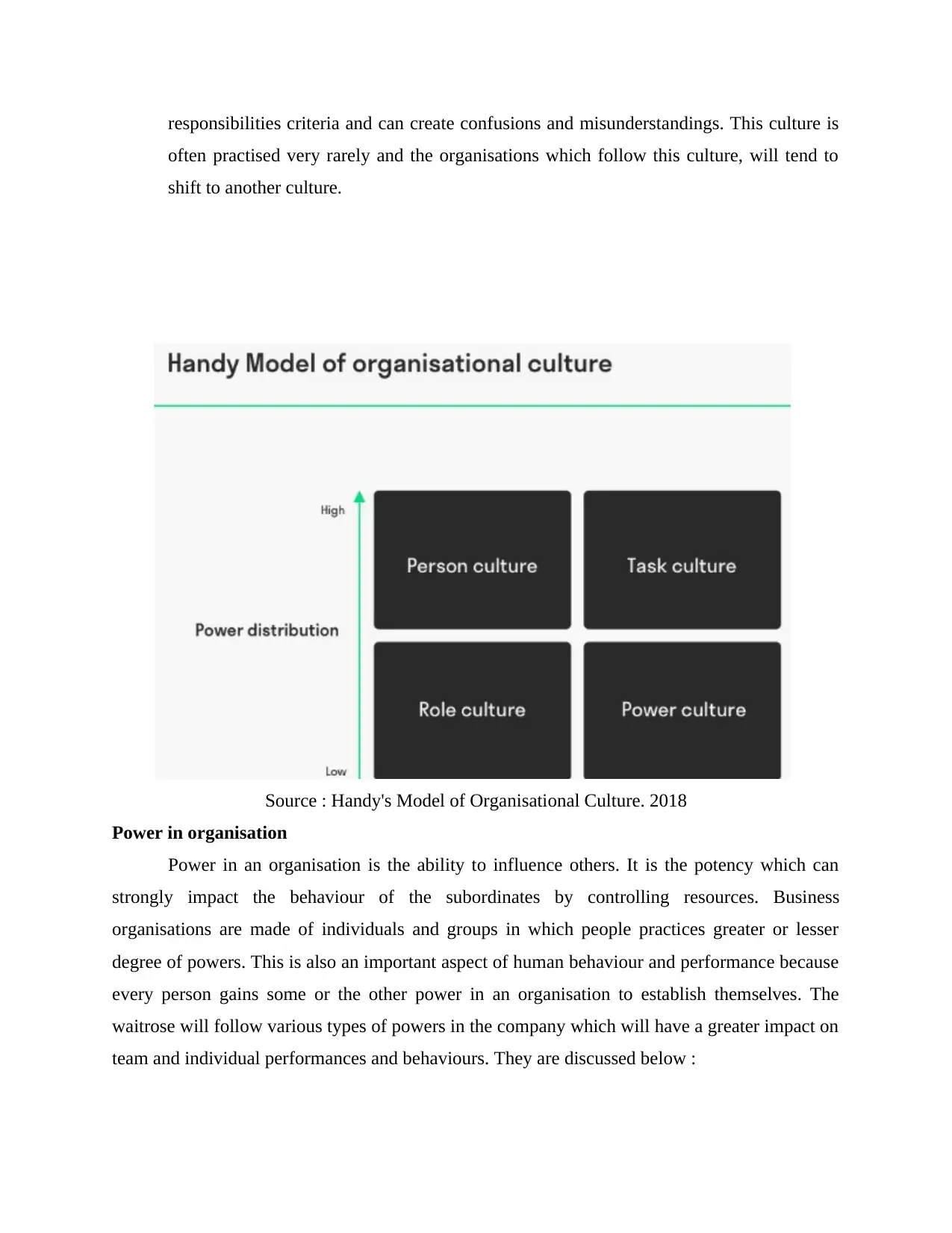
responsibilities criteria and can create confusions and misunderstandings. This culture is
often practised very rarely and the organisations which follow this culture, will tend to
shift to another culture.
Source : Handy's Model of Organisational Culture. 2018
Power in organisation
Power in an organisation is the ability to influence others. It is the potency which can
strongly impact the behaviour of the subordinates by controlling resources. Business
organisations are made of individuals and groups in which people practices greater or lesser
degree of powers. This is also an important aspect of human behaviour and performance because
every person gains some or the other power in an organisation to establish themselves. The
waitrose will follow various types of powers in the company which will have a greater impact on
team and individual performances and behaviours. They are discussed below :
often practised very rarely and the organisations which follow this culture, will tend to
shift to another culture.
Source : Handy's Model of Organisational Culture. 2018
Power in organisation
Power in an organisation is the ability to influence others. It is the potency which can
strongly impact the behaviour of the subordinates by controlling resources. Business
organisations are made of individuals and groups in which people practices greater or lesser
degree of powers. This is also an important aspect of human behaviour and performance because
every person gains some or the other power in an organisation to establish themselves. The
waitrose will follow various types of powers in the company which will have a greater impact on
team and individual performances and behaviours. They are discussed below :
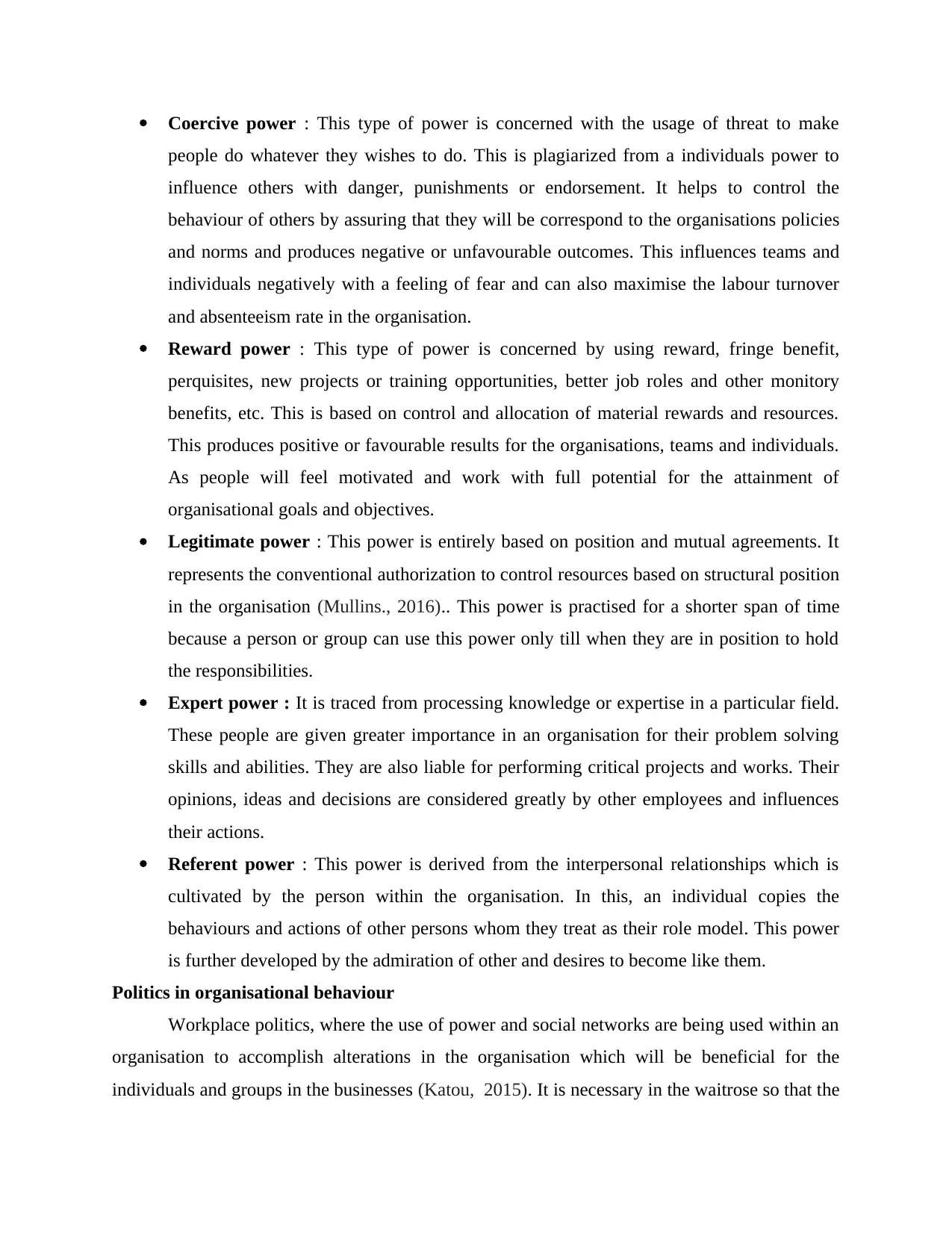
Coercive power : This type of power is concerned with the usage of threat to make
people do whatever they wishes to do. This is plagiarized from a individuals power to
influence others with danger, punishments or endorsement. It helps to control the
behaviour of others by assuring that they will be correspond to the organisations policies
and norms and produces negative or unfavourable outcomes. This influences teams and
individuals negatively with a feeling of fear and can also maximise the labour turnover
and absenteeism rate in the organisation.
Reward power : This type of power is concerned by using reward, fringe benefit,
perquisites, new projects or training opportunities, better job roles and other monitory
benefits, etc. This is based on control and allocation of material rewards and resources.
This produces positive or favourable results for the organisations, teams and individuals.
As people will feel motivated and work with full potential for the attainment of
organisational goals and objectives.
Legitimate power : This power is entirely based on position and mutual agreements. It
represents the conventional authorization to control resources based on structural position
in the organisation (Mullins., 2016).. This power is practised for a shorter span of time
because a person or group can use this power only till when they are in position to hold
the responsibilities.
Expert power : It is traced from processing knowledge or expertise in a particular field.
These people are given greater importance in an organisation for their problem solving
skills and abilities. They are also liable for performing critical projects and works. Their
opinions, ideas and decisions are considered greatly by other employees and influences
their actions.
Referent power : This power is derived from the interpersonal relationships which is
cultivated by the person within the organisation. In this, an individual copies the
behaviours and actions of other persons whom they treat as their role model. This power
is further developed by the admiration of other and desires to become like them.
Politics in organisational behaviour
Workplace politics, where the use of power and social networks are being used within an
organisation to accomplish alterations in the organisation which will be beneficial for the
individuals and groups in the businesses (Katou, 2015). It is necessary in the waitrose so that the
people do whatever they wishes to do. This is plagiarized from a individuals power to
influence others with danger, punishments or endorsement. It helps to control the
behaviour of others by assuring that they will be correspond to the organisations policies
and norms and produces negative or unfavourable outcomes. This influences teams and
individuals negatively with a feeling of fear and can also maximise the labour turnover
and absenteeism rate in the organisation.
Reward power : This type of power is concerned by using reward, fringe benefit,
perquisites, new projects or training opportunities, better job roles and other monitory
benefits, etc. This is based on control and allocation of material rewards and resources.
This produces positive or favourable results for the organisations, teams and individuals.
As people will feel motivated and work with full potential for the attainment of
organisational goals and objectives.
Legitimate power : This power is entirely based on position and mutual agreements. It
represents the conventional authorization to control resources based on structural position
in the organisation (Mullins., 2016).. This power is practised for a shorter span of time
because a person or group can use this power only till when they are in position to hold
the responsibilities.
Expert power : It is traced from processing knowledge or expertise in a particular field.
These people are given greater importance in an organisation for their problem solving
skills and abilities. They are also liable for performing critical projects and works. Their
opinions, ideas and decisions are considered greatly by other employees and influences
their actions.
Referent power : This power is derived from the interpersonal relationships which is
cultivated by the person within the organisation. In this, an individual copies the
behaviours and actions of other persons whom they treat as their role model. This power
is further developed by the admiration of other and desires to become like them.
Politics in organisational behaviour
Workplace politics, where the use of power and social networks are being used within an
organisation to accomplish alterations in the organisation which will be beneficial for the
individuals and groups in the businesses (Katou, 2015). It is necessary in the waitrose so that the
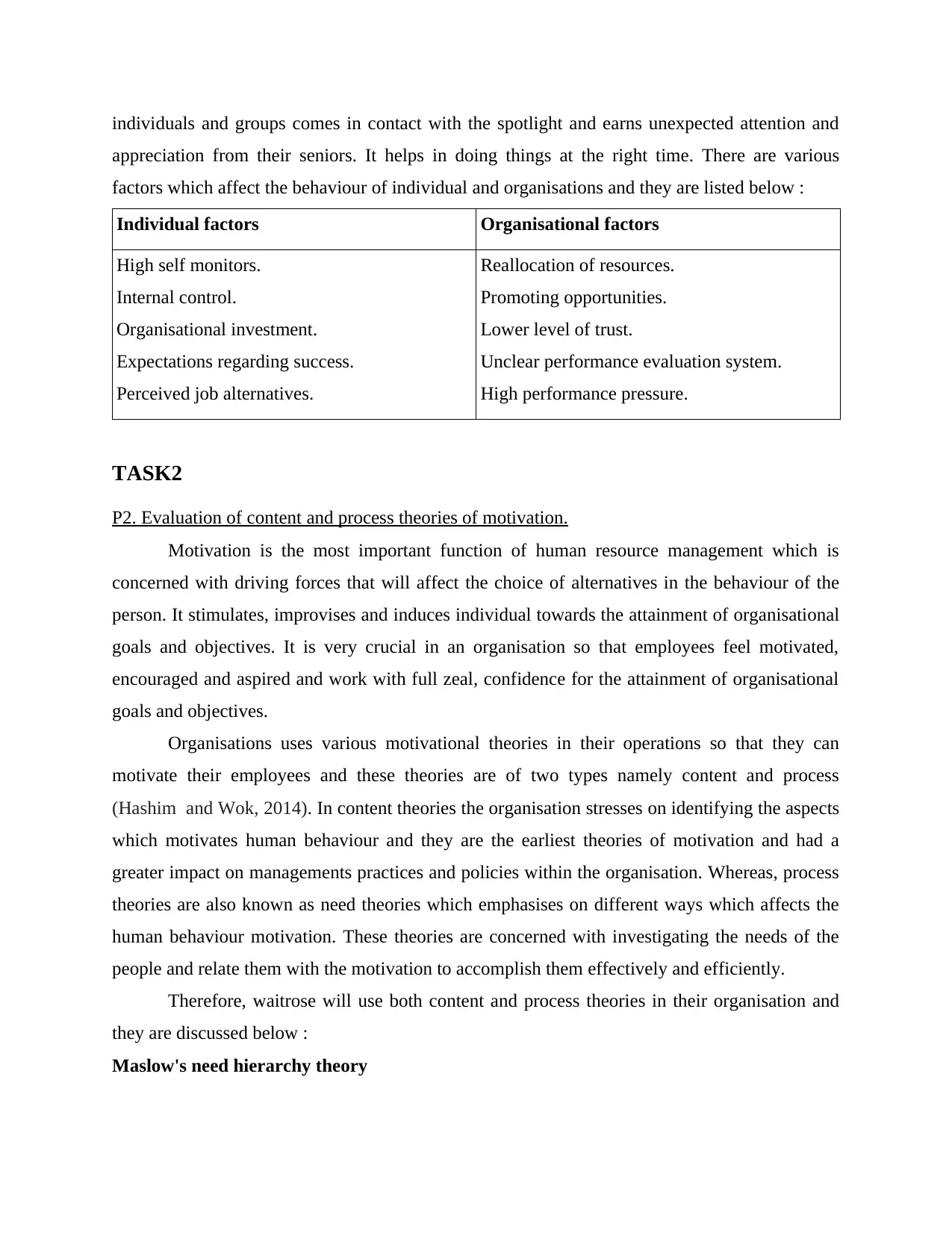
individuals and groups comes in contact with the spotlight and earns unexpected attention and
appreciation from their seniors. It helps in doing things at the right time. There are various
factors which affect the behaviour of individual and organisations and they are listed below :
Individual factors Organisational factors
High self monitors.
Internal control.
Organisational investment.
Expectations regarding success.
Perceived job alternatives.
Reallocation of resources.
Promoting opportunities.
Lower level of trust.
Unclear performance evaluation system.
High performance pressure.
TASK2
P2. Evaluation of content and process theories of motivation.
Motivation is the most important function of human resource management which is
concerned with driving forces that will affect the choice of alternatives in the behaviour of the
person. It stimulates, improvises and induces individual towards the attainment of organisational
goals and objectives. It is very crucial in an organisation so that employees feel motivated,
encouraged and aspired and work with full zeal, confidence for the attainment of organisational
goals and objectives.
Organisations uses various motivational theories in their operations so that they can
motivate their employees and these theories are of two types namely content and process
(Hashim and Wok, 2014). In content theories the organisation stresses on identifying the aspects
which motivates human behaviour and they are the earliest theories of motivation and had a
greater impact on managements practices and policies within the organisation. Whereas, process
theories are also known as need theories which emphasises on different ways which affects the
human behaviour motivation. These theories are concerned with investigating the needs of the
people and relate them with the motivation to accomplish them effectively and efficiently.
Therefore, waitrose will use both content and process theories in their organisation and
they are discussed below :
Maslow's need hierarchy theory
appreciation from their seniors. It helps in doing things at the right time. There are various
factors which affect the behaviour of individual and organisations and they are listed below :
Individual factors Organisational factors
High self monitors.
Internal control.
Organisational investment.
Expectations regarding success.
Perceived job alternatives.
Reallocation of resources.
Promoting opportunities.
Lower level of trust.
Unclear performance evaluation system.
High performance pressure.
TASK2
P2. Evaluation of content and process theories of motivation.
Motivation is the most important function of human resource management which is
concerned with driving forces that will affect the choice of alternatives in the behaviour of the
person. It stimulates, improvises and induces individual towards the attainment of organisational
goals and objectives. It is very crucial in an organisation so that employees feel motivated,
encouraged and aspired and work with full zeal, confidence for the attainment of organisational
goals and objectives.
Organisations uses various motivational theories in their operations so that they can
motivate their employees and these theories are of two types namely content and process
(Hashim and Wok, 2014). In content theories the organisation stresses on identifying the aspects
which motivates human behaviour and they are the earliest theories of motivation and had a
greater impact on managements practices and policies within the organisation. Whereas, process
theories are also known as need theories which emphasises on different ways which affects the
human behaviour motivation. These theories are concerned with investigating the needs of the
people and relate them with the motivation to accomplish them effectively and efficiently.
Therefore, waitrose will use both content and process theories in their organisation and
they are discussed below :
Maslow's need hierarchy theory
Paraphrase This Document
Need a fresh take? Get an instant paraphrase of this document with our AI Paraphraser
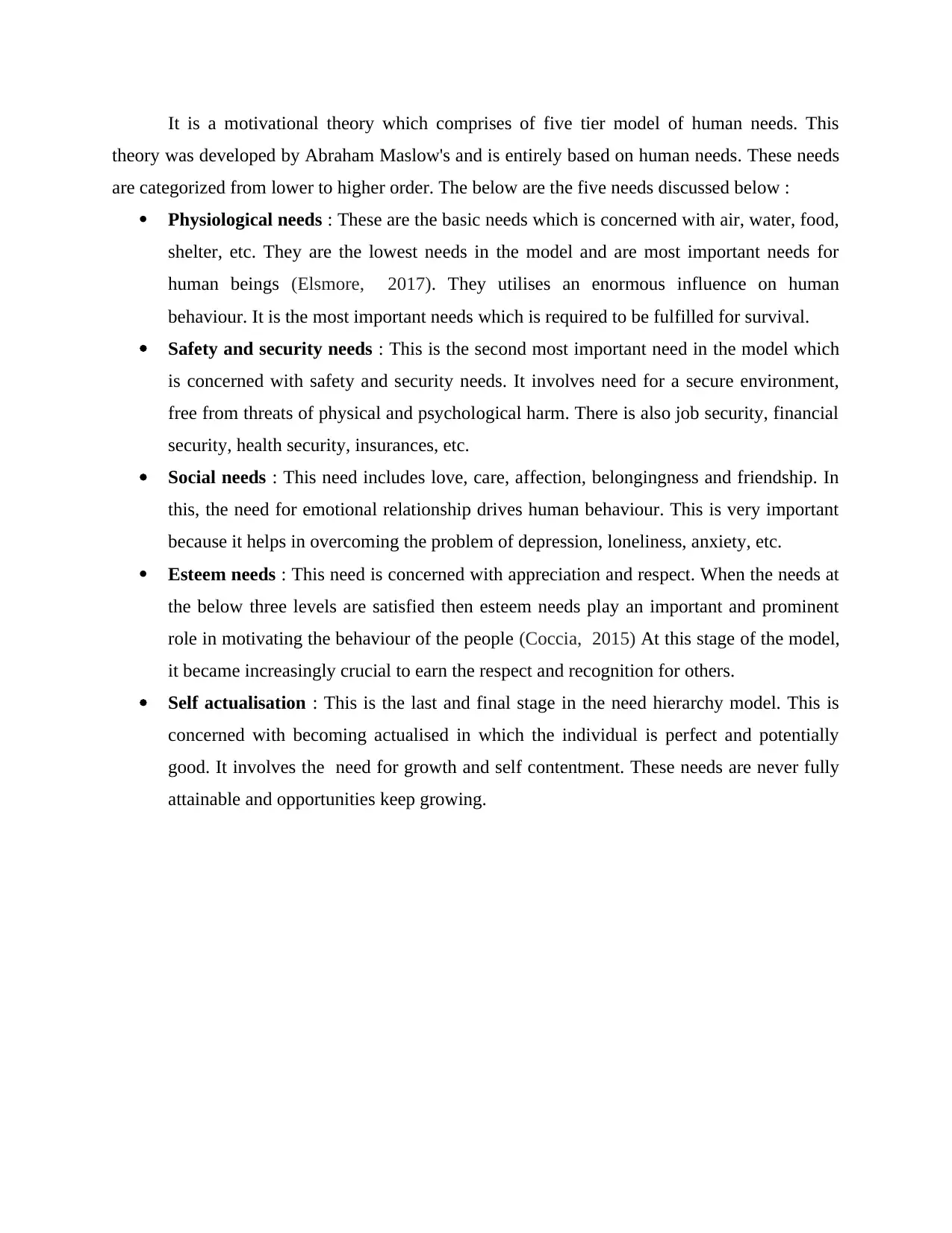
It is a motivational theory which comprises of five tier model of human needs. This
theory was developed by Abraham Maslow's and is entirely based on human needs. These needs
are categorized from lower to higher order. The below are the five needs discussed below :
Physiological needs : These are the basic needs which is concerned with air, water, food,
shelter, etc. They are the lowest needs in the model and are most important needs for
human beings (Elsmore, 2017). They utilises an enormous influence on human
behaviour. It is the most important needs which is required to be fulfilled for survival.
Safety and security needs : This is the second most important need in the model which
is concerned with safety and security needs. It involves need for a secure environment,
free from threats of physical and psychological harm. There is also job security, financial
security, health security, insurances, etc.
Social needs : This need includes love, care, affection, belongingness and friendship. In
this, the need for emotional relationship drives human behaviour. This is very important
because it helps in overcoming the problem of depression, loneliness, anxiety, etc.
Esteem needs : This need is concerned with appreciation and respect. When the needs at
the below three levels are satisfied then esteem needs play an important and prominent
role in motivating the behaviour of the people (Coccia, 2015) At this stage of the model,
it became increasingly crucial to earn the respect and recognition for others.
Self actualisation : This is the last and final stage in the need hierarchy model. This is
concerned with becoming actualised in which the individual is perfect and potentially
good. It involves the need for growth and self contentment. These needs are never fully
attainable and opportunities keep growing.
theory was developed by Abraham Maslow's and is entirely based on human needs. These needs
are categorized from lower to higher order. The below are the five needs discussed below :
Physiological needs : These are the basic needs which is concerned with air, water, food,
shelter, etc. They are the lowest needs in the model and are most important needs for
human beings (Elsmore, 2017). They utilises an enormous influence on human
behaviour. It is the most important needs which is required to be fulfilled for survival.
Safety and security needs : This is the second most important need in the model which
is concerned with safety and security needs. It involves need for a secure environment,
free from threats of physical and psychological harm. There is also job security, financial
security, health security, insurances, etc.
Social needs : This need includes love, care, affection, belongingness and friendship. In
this, the need for emotional relationship drives human behaviour. This is very important
because it helps in overcoming the problem of depression, loneliness, anxiety, etc.
Esteem needs : This need is concerned with appreciation and respect. When the needs at
the below three levels are satisfied then esteem needs play an important and prominent
role in motivating the behaviour of the people (Coccia, 2015) At this stage of the model,
it became increasingly crucial to earn the respect and recognition for others.
Self actualisation : This is the last and final stage in the need hierarchy model. This is
concerned with becoming actualised in which the individual is perfect and potentially
good. It involves the need for growth and self contentment. These needs are never fully
attainable and opportunities keep growing.
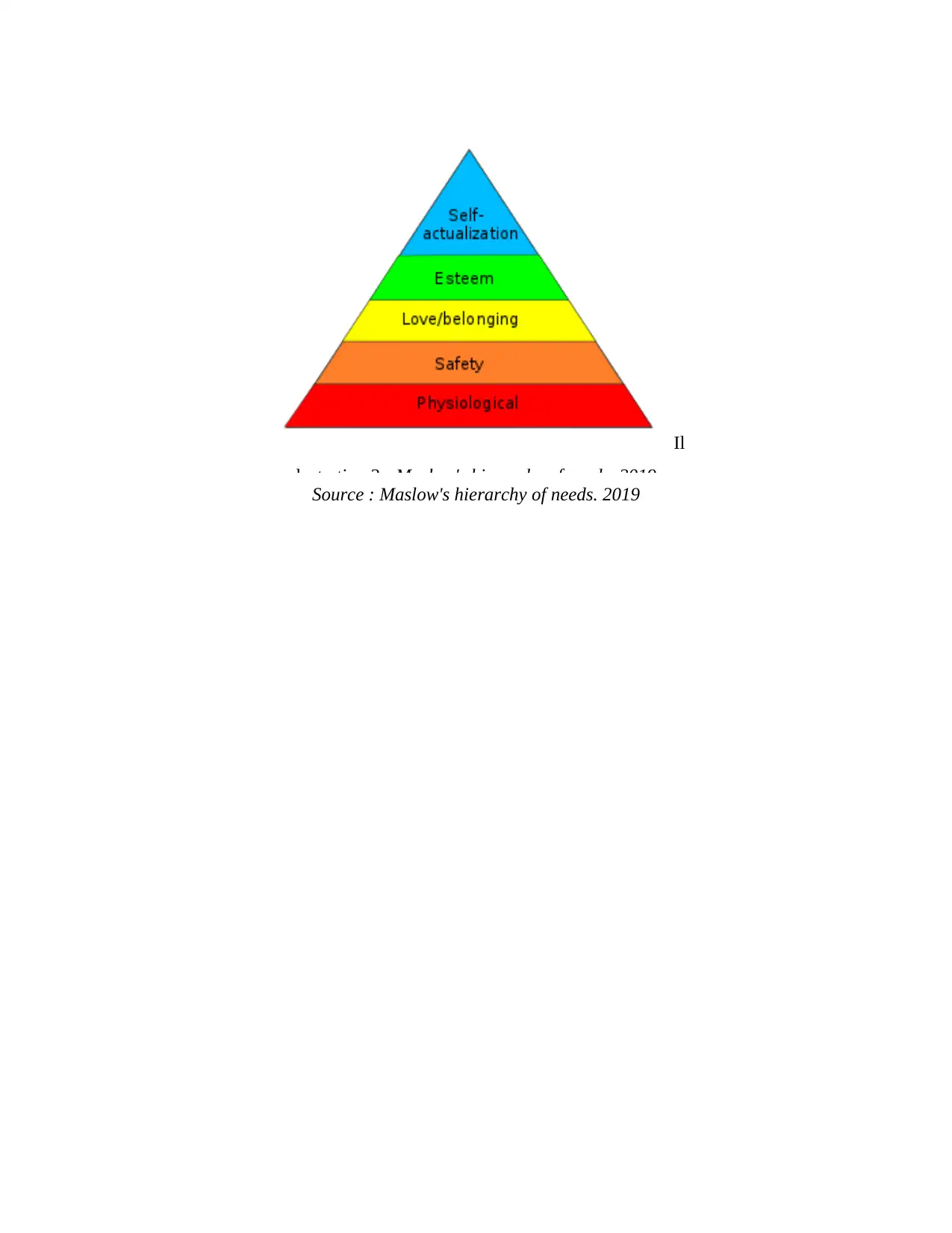
Source : Maslow's hierarchy of needs. 2019
Il
lustration 2: Maslow's hierarchy of needs. 2019
Il
lustration 2: Maslow's hierarchy of needs. 2019
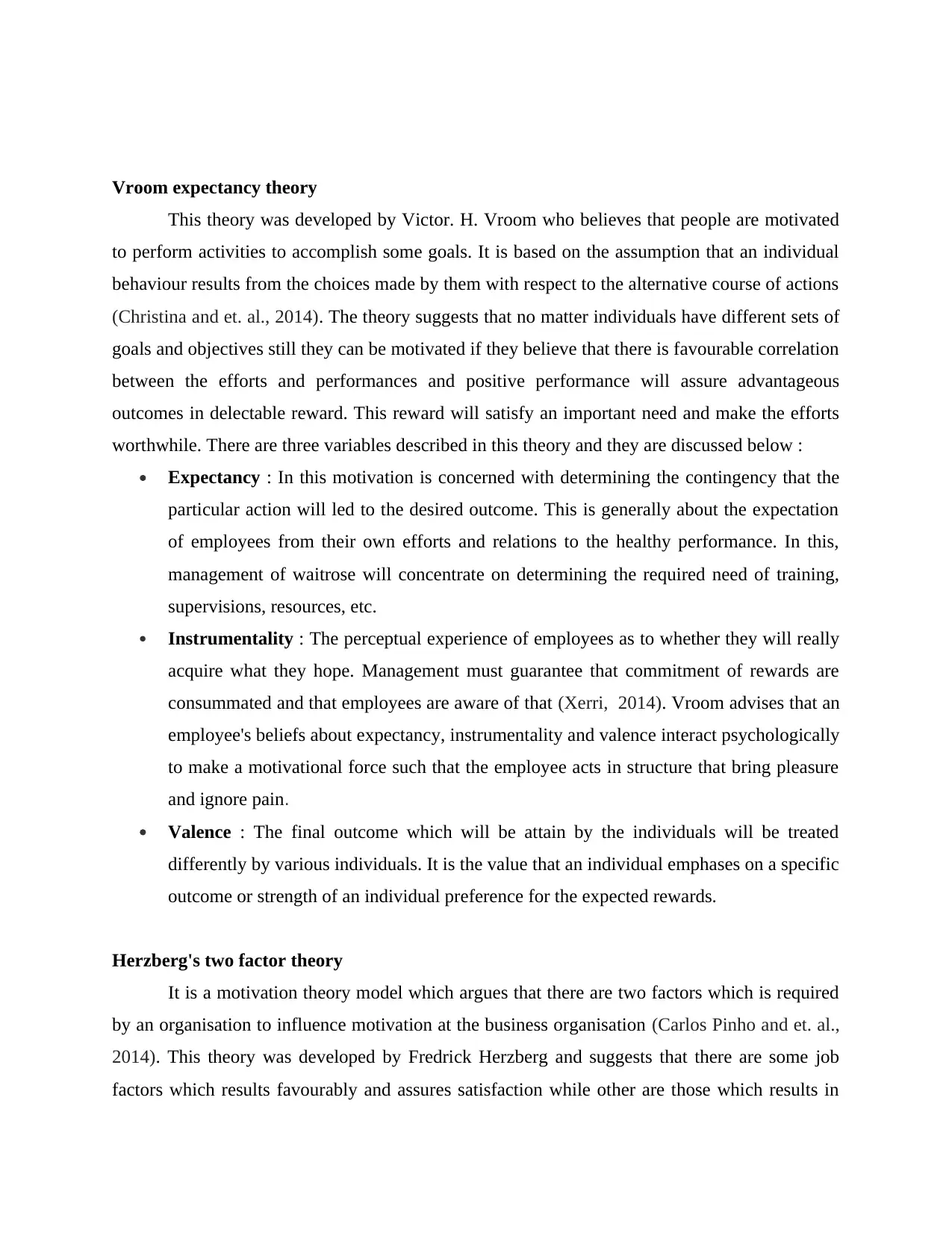
Vroom expectancy theory
This theory was developed by Victor. H. Vroom who believes that people are motivated
to perform activities to accomplish some goals. It is based on the assumption that an individual
behaviour results from the choices made by them with respect to the alternative course of actions
(Christina and et. al., 2014). The theory suggests that no matter individuals have different sets of
goals and objectives still they can be motivated if they believe that there is favourable correlation
between the efforts and performances and positive performance will assure advantageous
outcomes in delectable reward. This reward will satisfy an important need and make the efforts
worthwhile. There are three variables described in this theory and they are discussed below :
Expectancy : In this motivation is concerned with determining the contingency that the
particular action will led to the desired outcome. This is generally about the expectation
of employees from their own efforts and relations to the healthy performance. In this,
management of waitrose will concentrate on determining the required need of training,
supervisions, resources, etc.
Instrumentality : The perceptual experience of employees as to whether they will really
acquire what they hope. Management must guarantee that commitment of rewards are
consummated and that employees are aware of that (Xerri, 2014). Vroom advises that an
employee's beliefs about expectancy, instrumentality and valence interact psychologically
to make a motivational force such that the employee acts in structure that bring pleasure
and ignore pain.
Valence : The final outcome which will be attain by the individuals will be treated
differently by various individuals. It is the value that an individual emphases on a specific
outcome or strength of an individual preference for the expected rewards.
Herzberg's two factor theory
It is a motivation theory model which argues that there are two factors which is required
by an organisation to influence motivation at the business organisation (Carlos Pinho and et. al.,
2014). This theory was developed by Fredrick Herzberg and suggests that there are some job
factors which results favourably and assures satisfaction while other are those which results in
This theory was developed by Victor. H. Vroom who believes that people are motivated
to perform activities to accomplish some goals. It is based on the assumption that an individual
behaviour results from the choices made by them with respect to the alternative course of actions
(Christina and et. al., 2014). The theory suggests that no matter individuals have different sets of
goals and objectives still they can be motivated if they believe that there is favourable correlation
between the efforts and performances and positive performance will assure advantageous
outcomes in delectable reward. This reward will satisfy an important need and make the efforts
worthwhile. There are three variables described in this theory and they are discussed below :
Expectancy : In this motivation is concerned with determining the contingency that the
particular action will led to the desired outcome. This is generally about the expectation
of employees from their own efforts and relations to the healthy performance. In this,
management of waitrose will concentrate on determining the required need of training,
supervisions, resources, etc.
Instrumentality : The perceptual experience of employees as to whether they will really
acquire what they hope. Management must guarantee that commitment of rewards are
consummated and that employees are aware of that (Xerri, 2014). Vroom advises that an
employee's beliefs about expectancy, instrumentality and valence interact psychologically
to make a motivational force such that the employee acts in structure that bring pleasure
and ignore pain.
Valence : The final outcome which will be attain by the individuals will be treated
differently by various individuals. It is the value that an individual emphases on a specific
outcome or strength of an individual preference for the expected rewards.
Herzberg's two factor theory
It is a motivation theory model which argues that there are two factors which is required
by an organisation to influence motivation at the business organisation (Carlos Pinho and et. al.,
2014). This theory was developed by Fredrick Herzberg and suggests that there are some job
factors which results favourably and assures satisfaction while other are those which results in
Secure Best Marks with AI Grader
Need help grading? Try our AI Grader for instant feedback on your assignments.
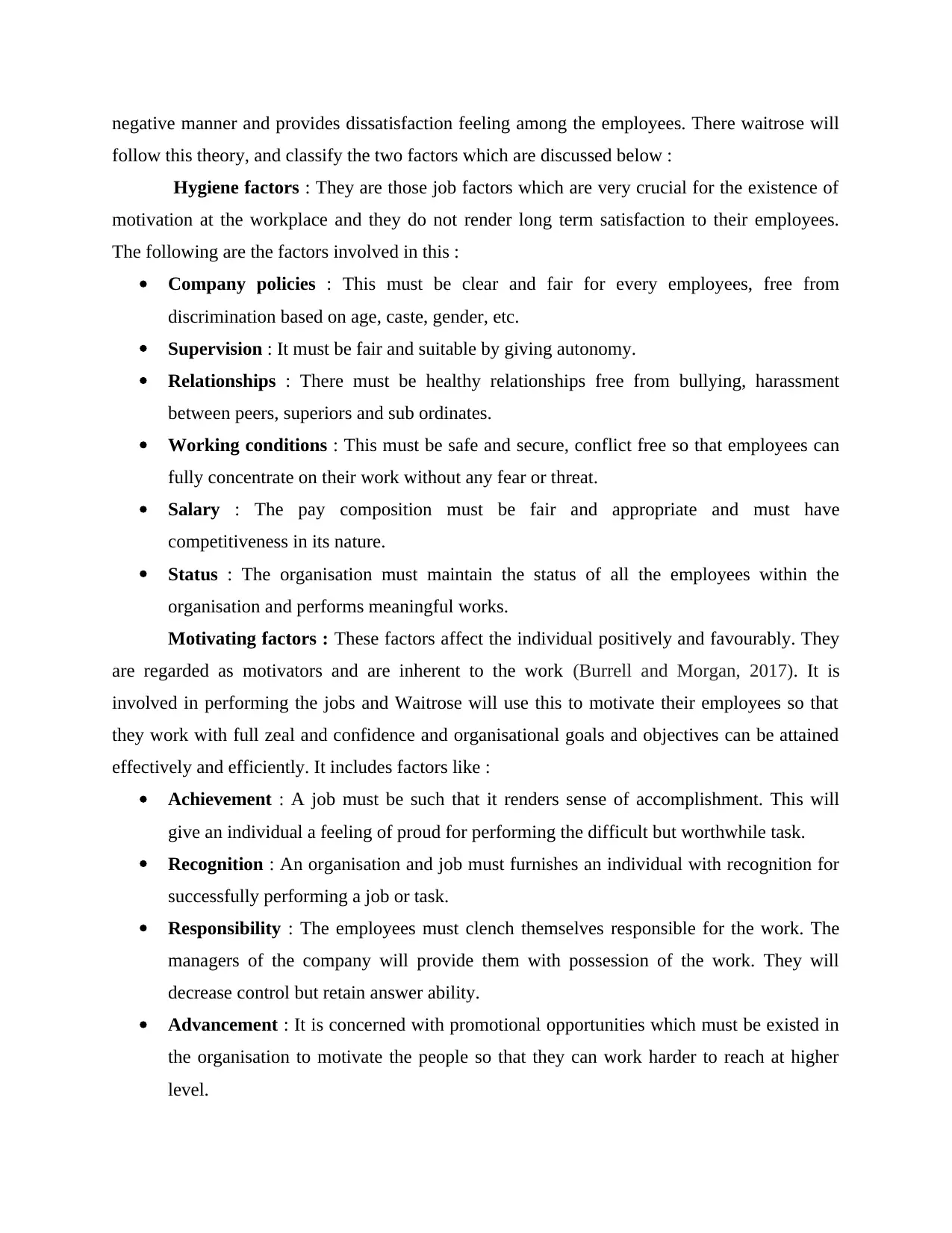
negative manner and provides dissatisfaction feeling among the employees. There waitrose will
follow this theory, and classify the two factors which are discussed below :
Hygiene factors : They are those job factors which are very crucial for the existence of
motivation at the workplace and they do not render long term satisfaction to their employees.
The following are the factors involved in this :
Company policies : This must be clear and fair for every employees, free from
discrimination based on age, caste, gender, etc.
Supervision : It must be fair and suitable by giving autonomy.
Relationships : There must be healthy relationships free from bullying, harassment
between peers, superiors and sub ordinates.
Working conditions : This must be safe and secure, conflict free so that employees can
fully concentrate on their work without any fear or threat.
Salary : The pay composition must be fair and appropriate and must have
competitiveness in its nature.
Status : The organisation must maintain the status of all the employees within the
organisation and performs meaningful works.
Motivating factors : These factors affect the individual positively and favourably. They
are regarded as motivators and are inherent to the work (Burrell and Morgan, 2017). It is
involved in performing the jobs and Waitrose will use this to motivate their employees so that
they work with full zeal and confidence and organisational goals and objectives can be attained
effectively and efficiently. It includes factors like :
Achievement : A job must be such that it renders sense of accomplishment. This will
give an individual a feeling of proud for performing the difficult but worthwhile task.
Recognition : An organisation and job must furnishes an individual with recognition for
successfully performing a job or task.
Responsibility : The employees must clench themselves responsible for the work. The
managers of the company will provide them with possession of the work. They will
decrease control but retain answer ability.
Advancement : It is concerned with promotional opportunities which must be existed in
the organisation to motivate the people so that they can work harder to reach at higher
level.
follow this theory, and classify the two factors which are discussed below :
Hygiene factors : They are those job factors which are very crucial for the existence of
motivation at the workplace and they do not render long term satisfaction to their employees.
The following are the factors involved in this :
Company policies : This must be clear and fair for every employees, free from
discrimination based on age, caste, gender, etc.
Supervision : It must be fair and suitable by giving autonomy.
Relationships : There must be healthy relationships free from bullying, harassment
between peers, superiors and sub ordinates.
Working conditions : This must be safe and secure, conflict free so that employees can
fully concentrate on their work without any fear or threat.
Salary : The pay composition must be fair and appropriate and must have
competitiveness in its nature.
Status : The organisation must maintain the status of all the employees within the
organisation and performs meaningful works.
Motivating factors : These factors affect the individual positively and favourably. They
are regarded as motivators and are inherent to the work (Burrell and Morgan, 2017). It is
involved in performing the jobs and Waitrose will use this to motivate their employees so that
they work with full zeal and confidence and organisational goals and objectives can be attained
effectively and efficiently. It includes factors like :
Achievement : A job must be such that it renders sense of accomplishment. This will
give an individual a feeling of proud for performing the difficult but worthwhile task.
Recognition : An organisation and job must furnishes an individual with recognition for
successfully performing a job or task.
Responsibility : The employees must clench themselves responsible for the work. The
managers of the company will provide them with possession of the work. They will
decrease control but retain answer ability.
Advancement : It is concerned with promotional opportunities which must be existed in
the organisation to motivate the people so that they can work harder to reach at higher
level.
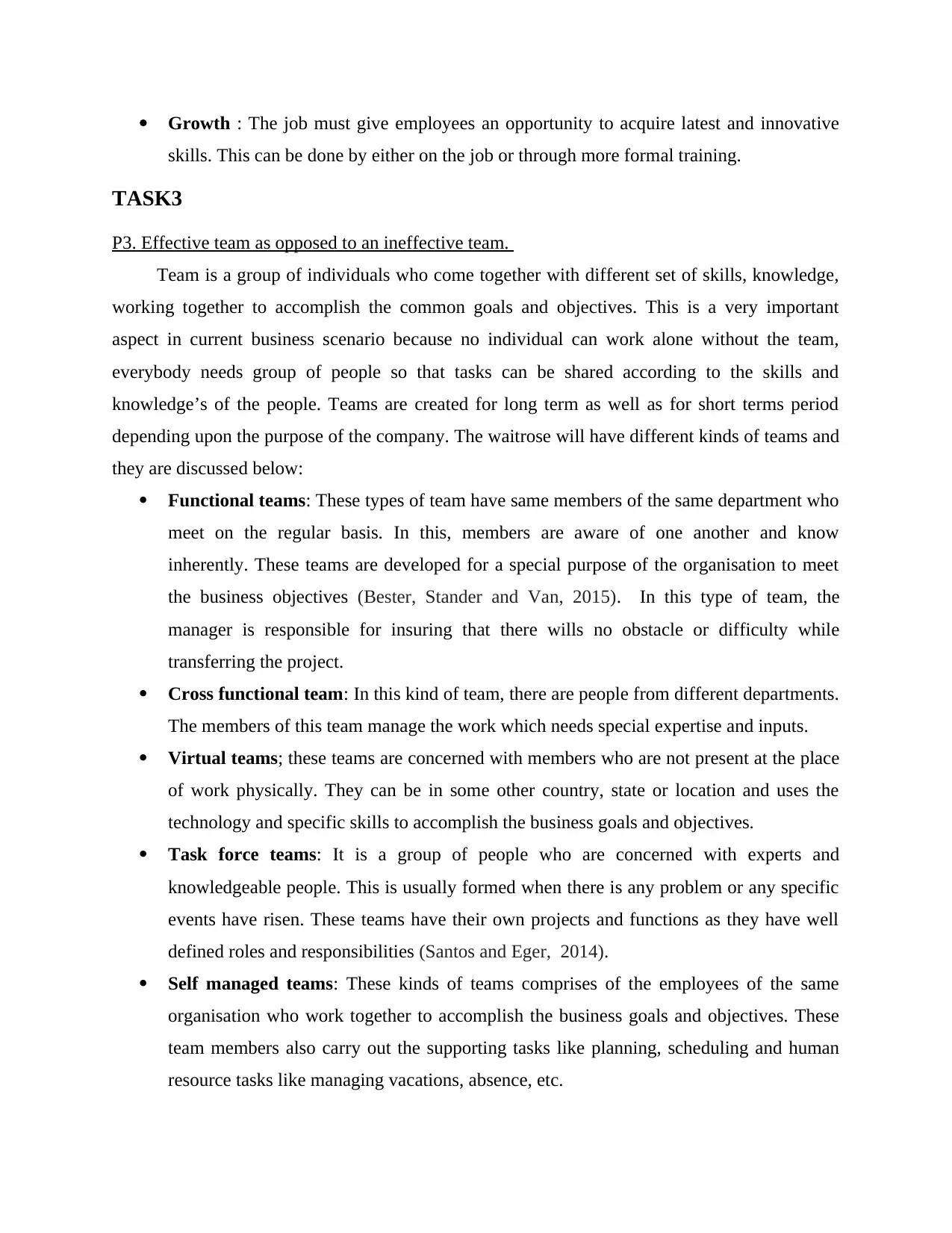
Growth : The job must give employees an opportunity to acquire latest and innovative
skills. This can be done by either on the job or through more formal training.
TASK3
P3. Effective team as opposed to an ineffective team.
Team is a group of individuals who come together with different set of skills, knowledge,
working together to accomplish the common goals and objectives. This is a very important
aspect in current business scenario because no individual can work alone without the team,
everybody needs group of people so that tasks can be shared according to the skills and
knowledge’s of the people. Teams are created for long term as well as for short terms period
depending upon the purpose of the company. The waitrose will have different kinds of teams and
they are discussed below:
Functional teams: These types of team have same members of the same department who
meet on the regular basis. In this, members are aware of one another and know
inherently. These teams are developed for a special purpose of the organisation to meet
the business objectives (Bester, Stander and Van, 2015). In this type of team, the
manager is responsible for insuring that there wills no obstacle or difficulty while
transferring the project.
Cross functional team: In this kind of team, there are people from different departments.
The members of this team manage the work which needs special expertise and inputs.
Virtual teams; these teams are concerned with members who are not present at the place
of work physically. They can be in some other country, state or location and uses the
technology and specific skills to accomplish the business goals and objectives.
Task force teams: It is a group of people who are concerned with experts and
knowledgeable people. This is usually formed when there is any problem or any specific
events have risen. These teams have their own projects and functions as they have well
defined roles and responsibilities (Santos and Eger, 2014).
Self managed teams: These kinds of teams comprises of the employees of the same
organisation who work together to accomplish the business goals and objectives. These
team members also carry out the supporting tasks like planning, scheduling and human
resource tasks like managing vacations, absence, etc.
skills. This can be done by either on the job or through more formal training.
TASK3
P3. Effective team as opposed to an ineffective team.
Team is a group of individuals who come together with different set of skills, knowledge,
working together to accomplish the common goals and objectives. This is a very important
aspect in current business scenario because no individual can work alone without the team,
everybody needs group of people so that tasks can be shared according to the skills and
knowledge’s of the people. Teams are created for long term as well as for short terms period
depending upon the purpose of the company. The waitrose will have different kinds of teams and
they are discussed below:
Functional teams: These types of team have same members of the same department who
meet on the regular basis. In this, members are aware of one another and know
inherently. These teams are developed for a special purpose of the organisation to meet
the business objectives (Bester, Stander and Van, 2015). In this type of team, the
manager is responsible for insuring that there wills no obstacle or difficulty while
transferring the project.
Cross functional team: In this kind of team, there are people from different departments.
The members of this team manage the work which needs special expertise and inputs.
Virtual teams; these teams are concerned with members who are not present at the place
of work physically. They can be in some other country, state or location and uses the
technology and specific skills to accomplish the business goals and objectives.
Task force teams: It is a group of people who are concerned with experts and
knowledgeable people. This is usually formed when there is any problem or any specific
events have risen. These teams have their own projects and functions as they have well
defined roles and responsibilities (Santos and Eger, 2014).
Self managed teams: These kinds of teams comprises of the employees of the same
organisation who work together to accomplish the business goals and objectives. These
team members also carry out the supporting tasks like planning, scheduling and human
resource tasks like managing vacations, absence, etc.
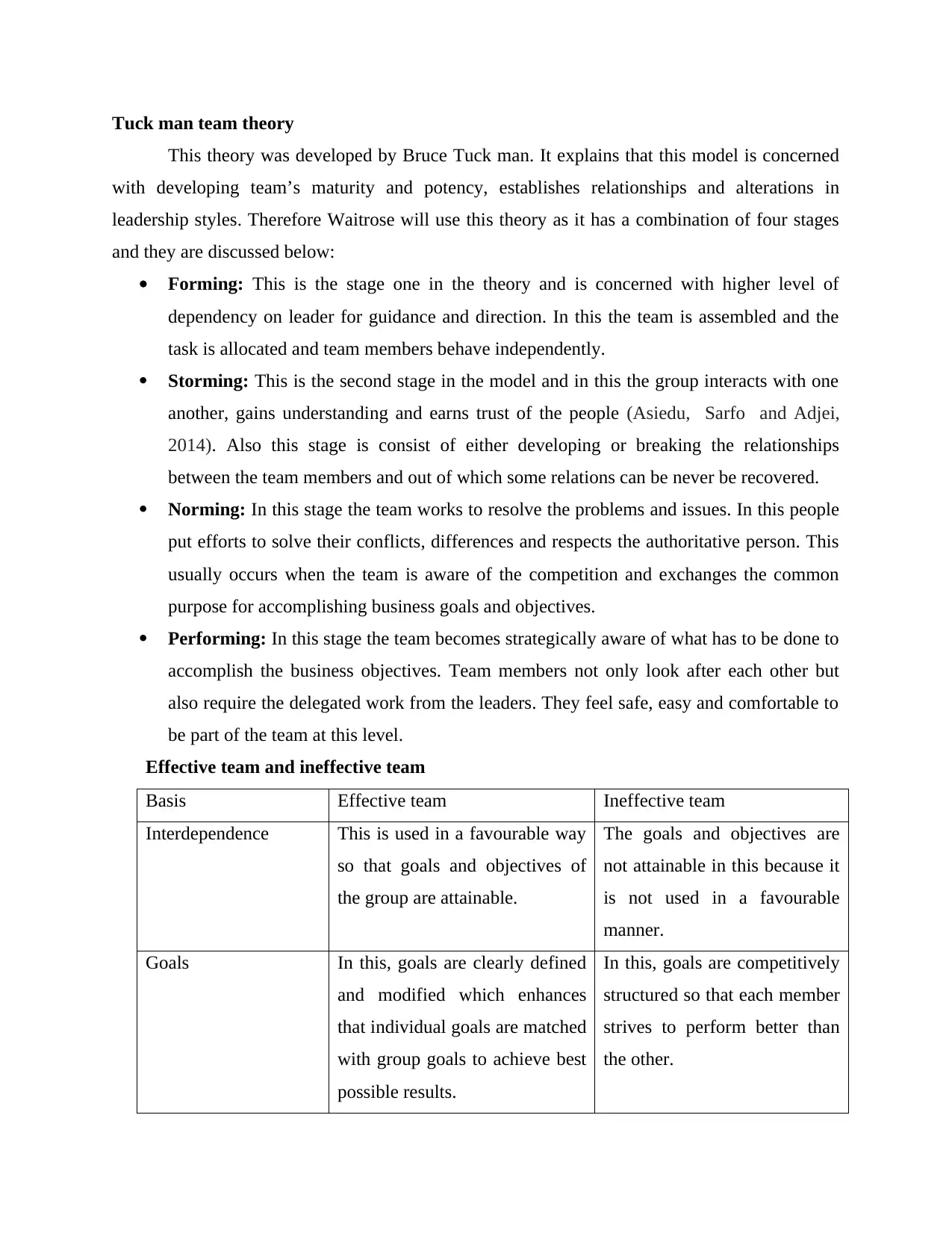
Tuck man team theory
This theory was developed by Bruce Tuck man. It explains that this model is concerned
with developing team’s maturity and potency, establishes relationships and alterations in
leadership styles. Therefore Waitrose will use this theory as it has a combination of four stages
and they are discussed below:
Forming: This is the stage one in the theory and is concerned with higher level of
dependency on leader for guidance and direction. In this the team is assembled and the
task is allocated and team members behave independently.
Storming: This is the second stage in the model and in this the group interacts with one
another, gains understanding and earns trust of the people (Asiedu, Sarfo and Adjei,
2014). Also this stage is consist of either developing or breaking the relationships
between the team members and out of which some relations can be never be recovered.
Norming: In this stage the team works to resolve the problems and issues. In this people
put efforts to solve their conflicts, differences and respects the authoritative person. This
usually occurs when the team is aware of the competition and exchanges the common
purpose for accomplishing business goals and objectives.
Performing: In this stage the team becomes strategically aware of what has to be done to
accomplish the business objectives. Team members not only look after each other but
also require the delegated work from the leaders. They feel safe, easy and comfortable to
be part of the team at this level.
Effective team and ineffective team
Basis Effective team Ineffective team
Interdependence This is used in a favourable way
so that goals and objectives of
the group are attainable.
The goals and objectives are
not attainable in this because it
is not used in a favourable
manner.
Goals In this, goals are clearly defined
and modified which enhances
that individual goals are matched
with group goals to achieve best
possible results.
In this, goals are competitively
structured so that each member
strives to perform better than
the other.
This theory was developed by Bruce Tuck man. It explains that this model is concerned
with developing team’s maturity and potency, establishes relationships and alterations in
leadership styles. Therefore Waitrose will use this theory as it has a combination of four stages
and they are discussed below:
Forming: This is the stage one in the theory and is concerned with higher level of
dependency on leader for guidance and direction. In this the team is assembled and the
task is allocated and team members behave independently.
Storming: This is the second stage in the model and in this the group interacts with one
another, gains understanding and earns trust of the people (Asiedu, Sarfo and Adjei,
2014). Also this stage is consist of either developing or breaking the relationships
between the team members and out of which some relations can be never be recovered.
Norming: In this stage the team works to resolve the problems and issues. In this people
put efforts to solve their conflicts, differences and respects the authoritative person. This
usually occurs when the team is aware of the competition and exchanges the common
purpose for accomplishing business goals and objectives.
Performing: In this stage the team becomes strategically aware of what has to be done to
accomplish the business objectives. Team members not only look after each other but
also require the delegated work from the leaders. They feel safe, easy and comfortable to
be part of the team at this level.
Effective team and ineffective team
Basis Effective team Ineffective team
Interdependence This is used in a favourable way
so that goals and objectives of
the group are attainable.
The goals and objectives are
not attainable in this because it
is not used in a favourable
manner.
Goals In this, goals are clearly defined
and modified which enhances
that individual goals are matched
with group goals to achieve best
possible results.
In this, goals are competitively
structured so that each member
strives to perform better than
the other.
Paraphrase This Document
Need a fresh take? Get an instant paraphrase of this document with our AI Paraphraser
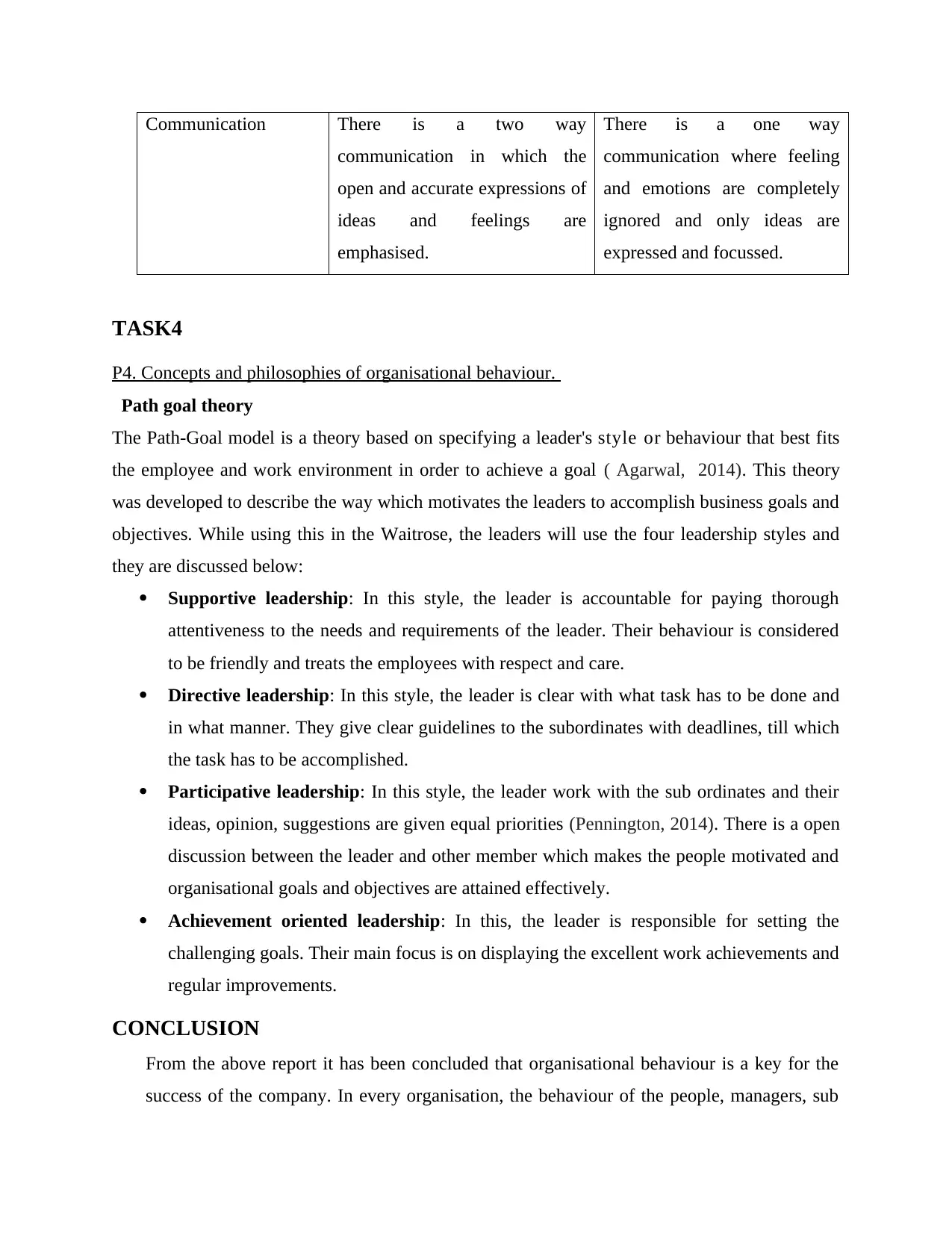
Communication There is a two way
communication in which the
open and accurate expressions of
ideas and feelings are
emphasised.
There is a one way
communication where feeling
and emotions are completely
ignored and only ideas are
expressed and focussed.
TASK4
P4. Concepts and philosophies of organisational behaviour.
Path goal theory
The Path-Goal model is a theory based on specifying a leader's style or behaviour that best fits
the employee and work environment in order to achieve a goal ( Agarwal, 2014). This theory
was developed to describe the way which motivates the leaders to accomplish business goals and
objectives. While using this in the Waitrose, the leaders will use the four leadership styles and
they are discussed below:
Supportive leadership: In this style, the leader is accountable for paying thorough
attentiveness to the needs and requirements of the leader. Their behaviour is considered
to be friendly and treats the employees with respect and care.
Directive leadership: In this style, the leader is clear with what task has to be done and
in what manner. They give clear guidelines to the subordinates with deadlines, till which
the task has to be accomplished.
Participative leadership: In this style, the leader work with the sub ordinates and their
ideas, opinion, suggestions are given equal priorities (Pennington, 2014). There is a open
discussion between the leader and other member which makes the people motivated and
organisational goals and objectives are attained effectively.
Achievement oriented leadership: In this, the leader is responsible for setting the
challenging goals. Their main focus is on displaying the excellent work achievements and
regular improvements.
CONCLUSION
From the above report it has been concluded that organisational behaviour is a key for the
success of the company. In every organisation, the behaviour of the people, managers, sub
communication in which the
open and accurate expressions of
ideas and feelings are
emphasised.
There is a one way
communication where feeling
and emotions are completely
ignored and only ideas are
expressed and focussed.
TASK4
P4. Concepts and philosophies of organisational behaviour.
Path goal theory
The Path-Goal model is a theory based on specifying a leader's style or behaviour that best fits
the employee and work environment in order to achieve a goal ( Agarwal, 2014). This theory
was developed to describe the way which motivates the leaders to accomplish business goals and
objectives. While using this in the Waitrose, the leaders will use the four leadership styles and
they are discussed below:
Supportive leadership: In this style, the leader is accountable for paying thorough
attentiveness to the needs and requirements of the leader. Their behaviour is considered
to be friendly and treats the employees with respect and care.
Directive leadership: In this style, the leader is clear with what task has to be done and
in what manner. They give clear guidelines to the subordinates with deadlines, till which
the task has to be accomplished.
Participative leadership: In this style, the leader work with the sub ordinates and their
ideas, opinion, suggestions are given equal priorities (Pennington, 2014). There is a open
discussion between the leader and other member which makes the people motivated and
organisational goals and objectives are attained effectively.
Achievement oriented leadership: In this, the leader is responsible for setting the
challenging goals. Their main focus is on displaying the excellent work achievements and
regular improvements.
CONCLUSION
From the above report it has been concluded that organisational behaviour is a key for the
success of the company. In every organisation, the behaviour of the people, managers, sub
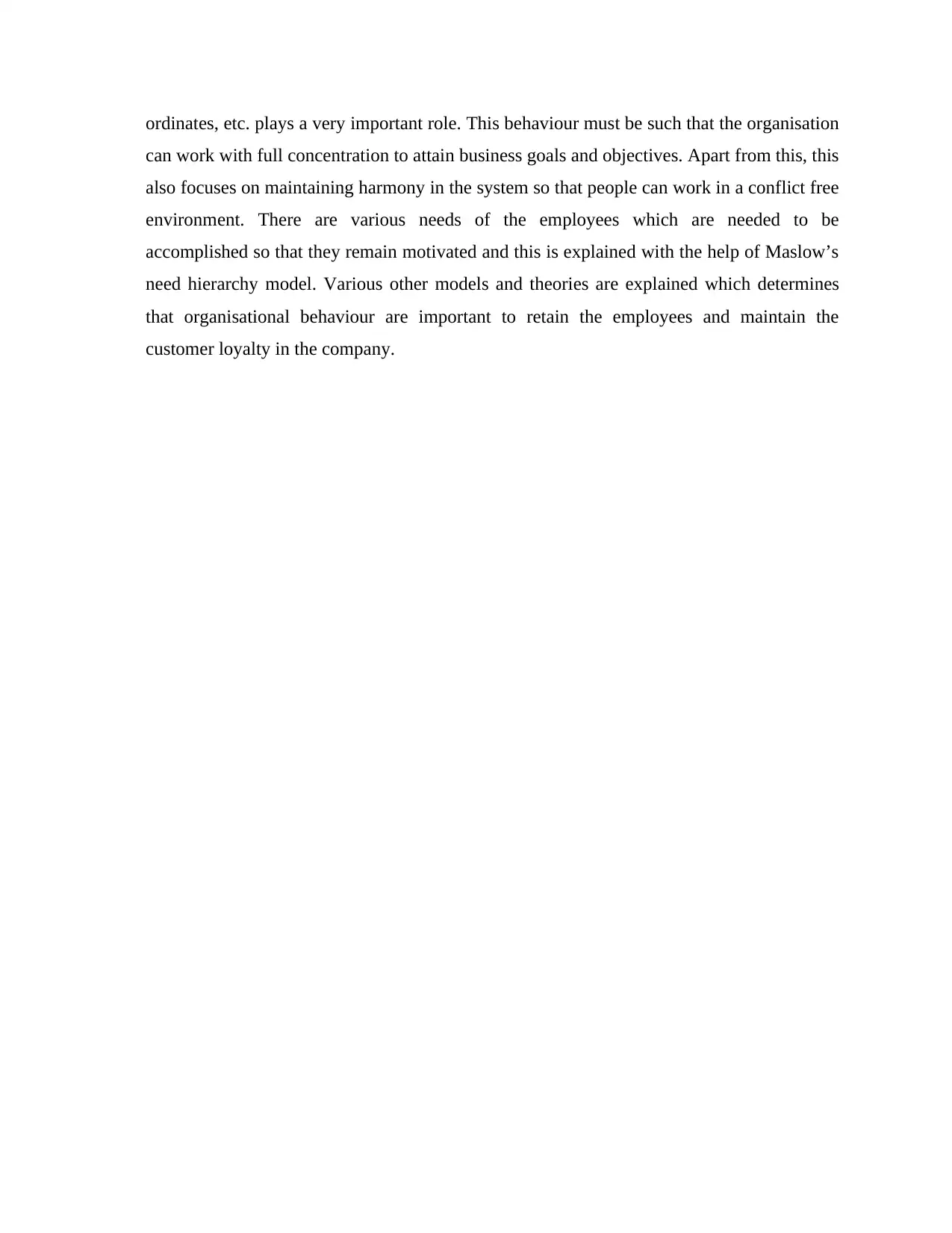
ordinates, etc. plays a very important role. This behaviour must be such that the organisation
can work with full concentration to attain business goals and objectives. Apart from this, this
also focuses on maintaining harmony in the system so that people can work in a conflict free
environment. There are various needs of the employees which are needed to be
accomplished so that they remain motivated and this is explained with the help of Maslow’s
need hierarchy model. Various other models and theories are explained which determines
that organisational behaviour are important to retain the employees and maintain the
customer loyalty in the company.
can work with full concentration to attain business goals and objectives. Apart from this, this
also focuses on maintaining harmony in the system so that people can work in a conflict free
environment. There are various needs of the employees which are needed to be
accomplished so that they remain motivated and this is explained with the help of Maslow’s
need hierarchy model. Various other models and theories are explained which determines
that organisational behaviour are important to retain the employees and maintain the
customer loyalty in the company.
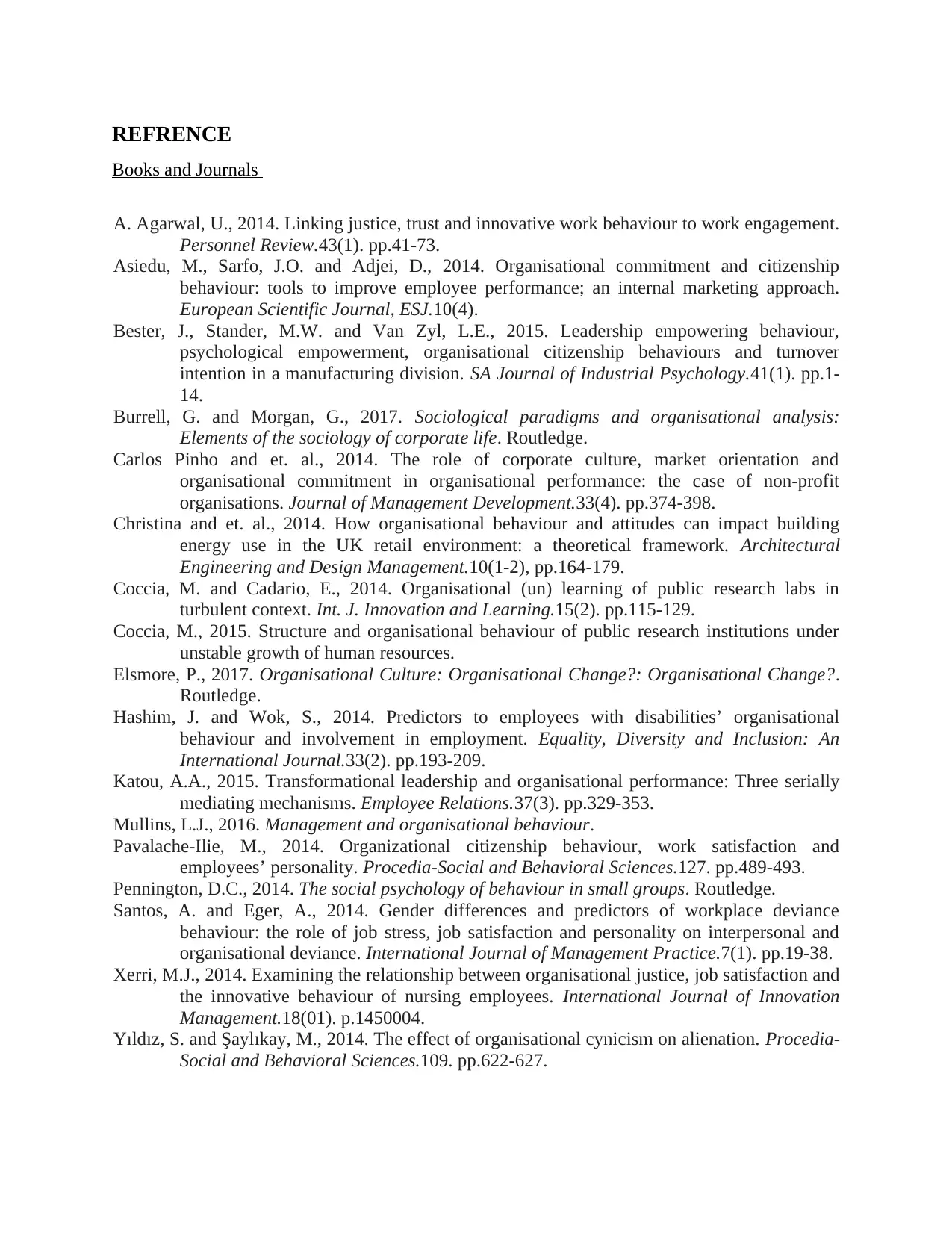
REFRENCE
Books and Journals
A. Agarwal, U., 2014. Linking justice, trust and innovative work behaviour to work engagement.
Personnel Review.43(1). pp.41-73.
Asiedu, M., Sarfo, J.O. and Adjei, D., 2014. Organisational commitment and citizenship
behaviour: tools to improve employee performance; an internal marketing approach.
European Scientific Journal, ESJ.10(4).
Bester, J., Stander, M.W. and Van Zyl, L.E., 2015. Leadership empowering behaviour,
psychological empowerment, organisational citizenship behaviours and turnover
intention in a manufacturing division. SA Journal of Industrial Psychology.41(1). pp.1-
14.
Burrell, G. and Morgan, G., 2017. Sociological paradigms and organisational analysis:
Elements of the sociology of corporate life. Routledge.
Carlos Pinho and et. al., 2014. The role of corporate culture, market orientation and
organisational commitment in organisational performance: the case of non-profit
organisations. Journal of Management Development.33(4). pp.374-398.
Christina and et. al., 2014. How organisational behaviour and attitudes can impact building
energy use in the UK retail environment: a theoretical framework. Architectural
Engineering and Design Management.10(1-2), pp.164-179.
Coccia, M. and Cadario, E., 2014. Organisational (un) learning of public research labs in
turbulent context. Int. J. Innovation and Learning.15(2). pp.115-129.
Coccia, M., 2015. Structure and organisational behaviour of public research institutions under
unstable growth of human resources.
Elsmore, P., 2017. Organisational Culture: Organisational Change?: Organisational Change?.
Routledge.
Hashim, J. and Wok, S., 2014. Predictors to employees with disabilities’ organisational
behaviour and involvement in employment. Equality, Diversity and Inclusion: An
International Journal.33(2). pp.193-209.
Katou, A.A., 2015. Transformational leadership and organisational performance: Three serially
mediating mechanisms. Employee Relations.37(3). pp.329-353.
Mullins, L.J., 2016. Management and organisational behaviour.
Pavalache-Ilie, M., 2014. Organizational citizenship behaviour, work satisfaction and
employees’ personality. Procedia-Social and Behavioral Sciences.127. pp.489-493.
Pennington, D.C., 2014. The social psychology of behaviour in small groups. Routledge.
Santos, A. and Eger, A., 2014. Gender differences and predictors of workplace deviance
behaviour: the role of job stress, job satisfaction and personality on interpersonal and
organisational deviance. International Journal of Management Practice.7(1). pp.19-38.
Xerri, M.J., 2014. Examining the relationship between organisational justice, job satisfaction and
the innovative behaviour of nursing employees. International Journal of Innovation
Management.18(01). p.1450004.
Yıldız, S. and Şaylıkay, M., 2014. The effect of organisational cynicism on alienation. Procedia-
Social and Behavioral Sciences.109. pp.622-627.
Books and Journals
A. Agarwal, U., 2014. Linking justice, trust and innovative work behaviour to work engagement.
Personnel Review.43(1). pp.41-73.
Asiedu, M., Sarfo, J.O. and Adjei, D., 2014. Organisational commitment and citizenship
behaviour: tools to improve employee performance; an internal marketing approach.
European Scientific Journal, ESJ.10(4).
Bester, J., Stander, M.W. and Van Zyl, L.E., 2015. Leadership empowering behaviour,
psychological empowerment, organisational citizenship behaviours and turnover
intention in a manufacturing division. SA Journal of Industrial Psychology.41(1). pp.1-
14.
Burrell, G. and Morgan, G., 2017. Sociological paradigms and organisational analysis:
Elements of the sociology of corporate life. Routledge.
Carlos Pinho and et. al., 2014. The role of corporate culture, market orientation and
organisational commitment in organisational performance: the case of non-profit
organisations. Journal of Management Development.33(4). pp.374-398.
Christina and et. al., 2014. How organisational behaviour and attitudes can impact building
energy use in the UK retail environment: a theoretical framework. Architectural
Engineering and Design Management.10(1-2), pp.164-179.
Coccia, M. and Cadario, E., 2014. Organisational (un) learning of public research labs in
turbulent context. Int. J. Innovation and Learning.15(2). pp.115-129.
Coccia, M., 2015. Structure and organisational behaviour of public research institutions under
unstable growth of human resources.
Elsmore, P., 2017. Organisational Culture: Organisational Change?: Organisational Change?.
Routledge.
Hashim, J. and Wok, S., 2014. Predictors to employees with disabilities’ organisational
behaviour and involvement in employment. Equality, Diversity and Inclusion: An
International Journal.33(2). pp.193-209.
Katou, A.A., 2015. Transformational leadership and organisational performance: Three serially
mediating mechanisms. Employee Relations.37(3). pp.329-353.
Mullins, L.J., 2016. Management and organisational behaviour.
Pavalache-Ilie, M., 2014. Organizational citizenship behaviour, work satisfaction and
employees’ personality. Procedia-Social and Behavioral Sciences.127. pp.489-493.
Pennington, D.C., 2014. The social psychology of behaviour in small groups. Routledge.
Santos, A. and Eger, A., 2014. Gender differences and predictors of workplace deviance
behaviour: the role of job stress, job satisfaction and personality on interpersonal and
organisational deviance. International Journal of Management Practice.7(1). pp.19-38.
Xerri, M.J., 2014. Examining the relationship between organisational justice, job satisfaction and
the innovative behaviour of nursing employees. International Journal of Innovation
Management.18(01). p.1450004.
Yıldız, S. and Şaylıkay, M., 2014. The effect of organisational cynicism on alienation. Procedia-
Social and Behavioral Sciences.109. pp.622-627.
Secure Best Marks with AI Grader
Need help grading? Try our AI Grader for instant feedback on your assignments.
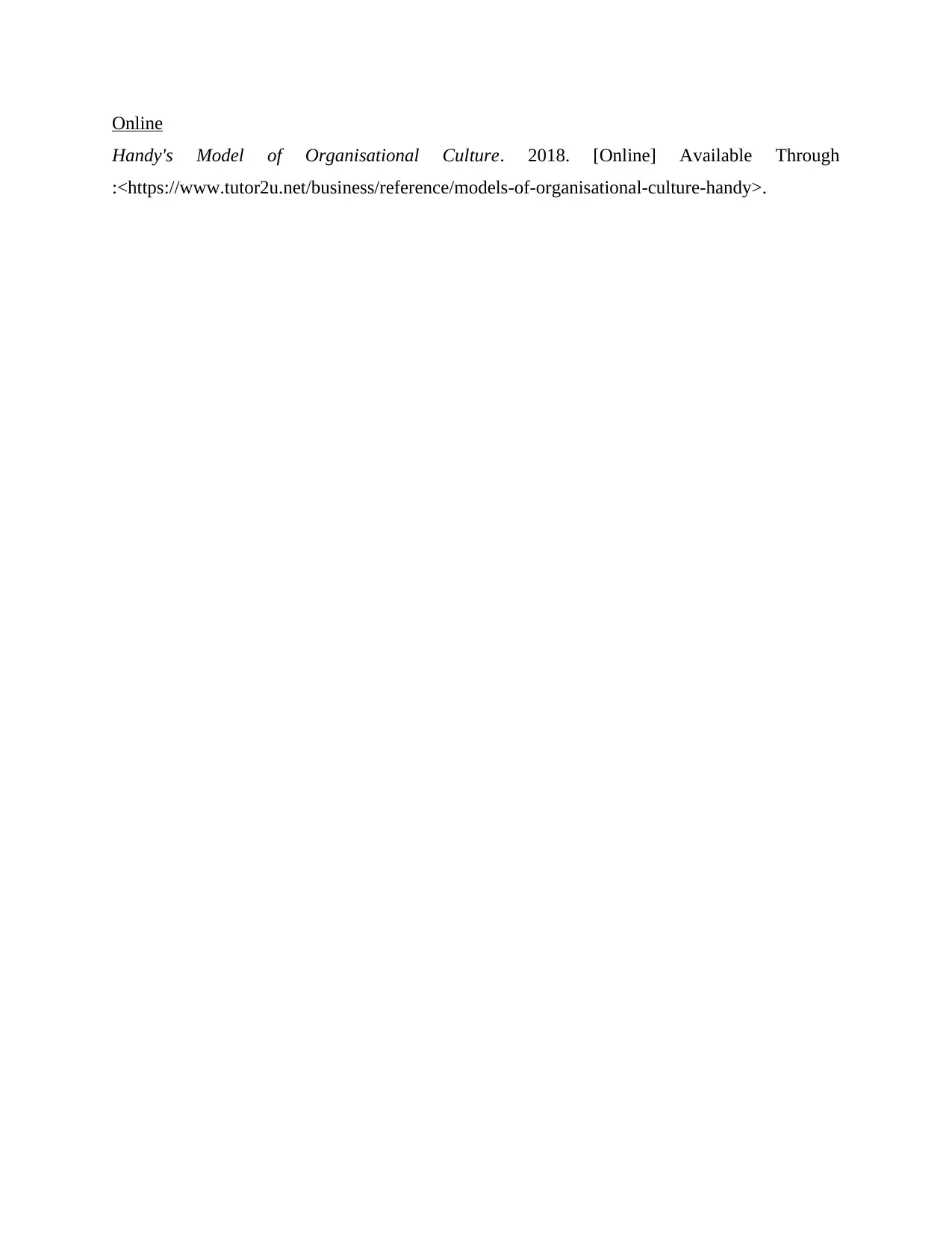
Online
Handy's Model of Organisational Culture. 2018. [Online] Available Through
:<https://www.tutor2u.net/business/reference/models-of-organisational-culture-handy>.
Handy's Model of Organisational Culture. 2018. [Online] Available Through
:<https://www.tutor2u.net/business/reference/models-of-organisational-culture-handy>.
1 out of 17
Related Documents
Your All-in-One AI-Powered Toolkit for Academic Success.
+13062052269
info@desklib.com
Available 24*7 on WhatsApp / Email
![[object Object]](/_next/static/media/star-bottom.7253800d.svg)
Unlock your academic potential
© 2024 | Zucol Services PVT LTD | All rights reserved.




